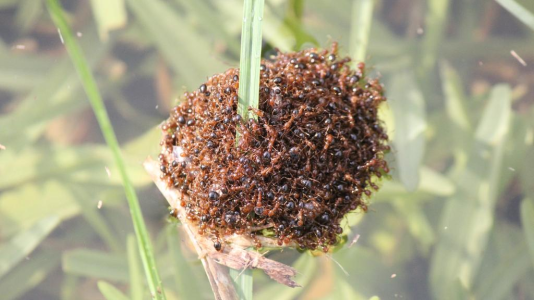Australia on the Brink: The Massive Problem That May Soon Sweep the Nation
By
Gian T
- Replies 3
Australia, a land renowned for its unique and diverse ecosystem, is facing a potential ecological crisis that could ripple across the nation, affecting the environment, human health, and agricultural productivity. The culprit? A tiny but formidable adversary – the red imported fire ant (Solenopsis invicta). If left unchecked, this invasive species could lead to a 'national disaster,' with experts warning of its spread from Queensland to New South Wales and potentially beyond.
The red imported fire ant from South America has already established a significant foothold in Southeast Queensland, infesting approximately 830,000 hectares near the NSW border. Alarmingly, these aggressive pests have been detected in northern NSW this month, having hitched a ride in turf delivered from Southeast Queensland. The discovery was made by a landscaping contractor in Clunes, near Byron Bay, highlighting the ease with which these ants can infiltrate new areas.
The NSW Department of Primary Industries has swiftly responded to the threat, treating the site to eradicate the ants and issuing biosecurity directions to prevent the movement of potentially infested lawn materials. However, the incident has raised serious concerns about the effectiveness of containment strategies and the need for increased vigilance and resources.
The National Fire Ant Eradication Program (NFAEP), to eradicate the pest from Australia by 2032, is investigating the breach, which occurred despite the turf being certified as treated before transport. The stakes are high, as fire ants are not only a threat to native wildlife but also to humans and pets. Their venomous sting can cause severe pain, allergic reactions, and in extreme cases, death. The Invasive Species Council's Advocacy Manager, Reece Pianta, who has experienced the sting himself, describes it as 'dozens of little paper cuts' with pain that can persist for days or weeks.
The potential human toll is sobering. A report by The Australia Institute (TAI) suggests that if their spread continues, fire ants could be responsible for six deaths every year in Queensland alone. The economic impact is equally daunting, with each electorate potentially facing over $2 million in control costs annually, not to mention the additional medical and veterinary expenses.
The recent incursion is a stark reminder of the urgency required to address this issue. Nationals Leader David Littleproud has criticised the previous Queensland Labor government's response, and the new Queensland liberal government is being urged to prioritise fire ant eradication within its first 100 days.
Concern over the toxicity of the NFAEP's ant baits complicates eradication efforts. Some landholders fear the impact on the ecosystem and their livestock, leading to calls for alternative methods, such as hot water injections into ant colonies. However, the NFAEP maintains that the granular treatments are safe and approved by Australia's pesticides and veterinary medicine authority and the Therapeutic Goods Administration (TGA).
As the government continues its eradication efforts, it's clear that fire ants are a national issue requiring a collective response. Australians are encouraged to remain vigilant, report fire ant nests, and participate in government bait programs if they live in affected zones. The battle against fire ants is not just a government responsibility; it's a shared one, with every citizen playing a crucial role in safeguarding Australia's cherished environment and way of life.
 So, dear members of the Seniors Discount Club, stay informed about this pressing issue. Monitor your gardens and community spaces for any signs of fire and activity. Report any sightings to the appropriate authorities and engage in community efforts to prevent their spread. Together, we can protect our beautiful country from this invasive threat. Let's keep the red imported fire ant from turning our home into its next conquest.
So, dear members of the Seniors Discount Club, stay informed about this pressing issue. Monitor your gardens and community spaces for any signs of fire and activity. Report any sightings to the appropriate authorities and engage in community efforts to prevent their spread. Together, we can protect our beautiful country from this invasive threat. Let's keep the red imported fire ant from turning our home into its next conquest.
The red imported fire ant from South America has already established a significant foothold in Southeast Queensland, infesting approximately 830,000 hectares near the NSW border. Alarmingly, these aggressive pests have been detected in northern NSW this month, having hitched a ride in turf delivered from Southeast Queensland. The discovery was made by a landscaping contractor in Clunes, near Byron Bay, highlighting the ease with which these ants can infiltrate new areas.
The NSW Department of Primary Industries has swiftly responded to the threat, treating the site to eradicate the ants and issuing biosecurity directions to prevent the movement of potentially infested lawn materials. However, the incident has raised serious concerns about the effectiveness of containment strategies and the need for increased vigilance and resources.
The National Fire Ant Eradication Program (NFAEP), to eradicate the pest from Australia by 2032, is investigating the breach, which occurred despite the turf being certified as treated before transport. The stakes are high, as fire ants are not only a threat to native wildlife but also to humans and pets. Their venomous sting can cause severe pain, allergic reactions, and in extreme cases, death. The Invasive Species Council's Advocacy Manager, Reece Pianta, who has experienced the sting himself, describes it as 'dozens of little paper cuts' with pain that can persist for days or weeks.
The potential human toll is sobering. A report by The Australia Institute (TAI) suggests that if their spread continues, fire ants could be responsible for six deaths every year in Queensland alone. The economic impact is equally daunting, with each electorate potentially facing over $2 million in control costs annually, not to mention the additional medical and veterinary expenses.
The recent incursion is a stark reminder of the urgency required to address this issue. Nationals Leader David Littleproud has criticised the previous Queensland Labor government's response, and the new Queensland liberal government is being urged to prioritise fire ant eradication within its first 100 days.
Concern over the toxicity of the NFAEP's ant baits complicates eradication efforts. Some landholders fear the impact on the ecosystem and their livestock, leading to calls for alternative methods, such as hot water injections into ant colonies. However, the NFAEP maintains that the granular treatments are safe and approved by Australia's pesticides and veterinary medicine authority and the Therapeutic Goods Administration (TGA).
As the government continues its eradication efforts, it's clear that fire ants are a national issue requiring a collective response. Australians are encouraged to remain vigilant, report fire ant nests, and participate in government bait programs if they live in affected zones. The battle against fire ants is not just a government responsibility; it's a shared one, with every citizen playing a crucial role in safeguarding Australia's cherished environment and way of life.
Key Takeaways
- Red imported fire ants, an invasive species, have spread from Queensland to New South Wales, posing a significant ecological and health threat.
- The recent detection of these pests in northern NSW has led to urgent treatment and raised concerns about their potential to spread further, especially through materials such as turf.
- The Australia Institute warns that if fire ants are not properly contained, they could cause six human deaths per year in Queensland, along with substantial agricultural and medical costs.
- Experts urge increased resources for the National Fire Ant Eradication Program and emphasise the importance of community vigilance and government action to prevent a widespread disaster.








